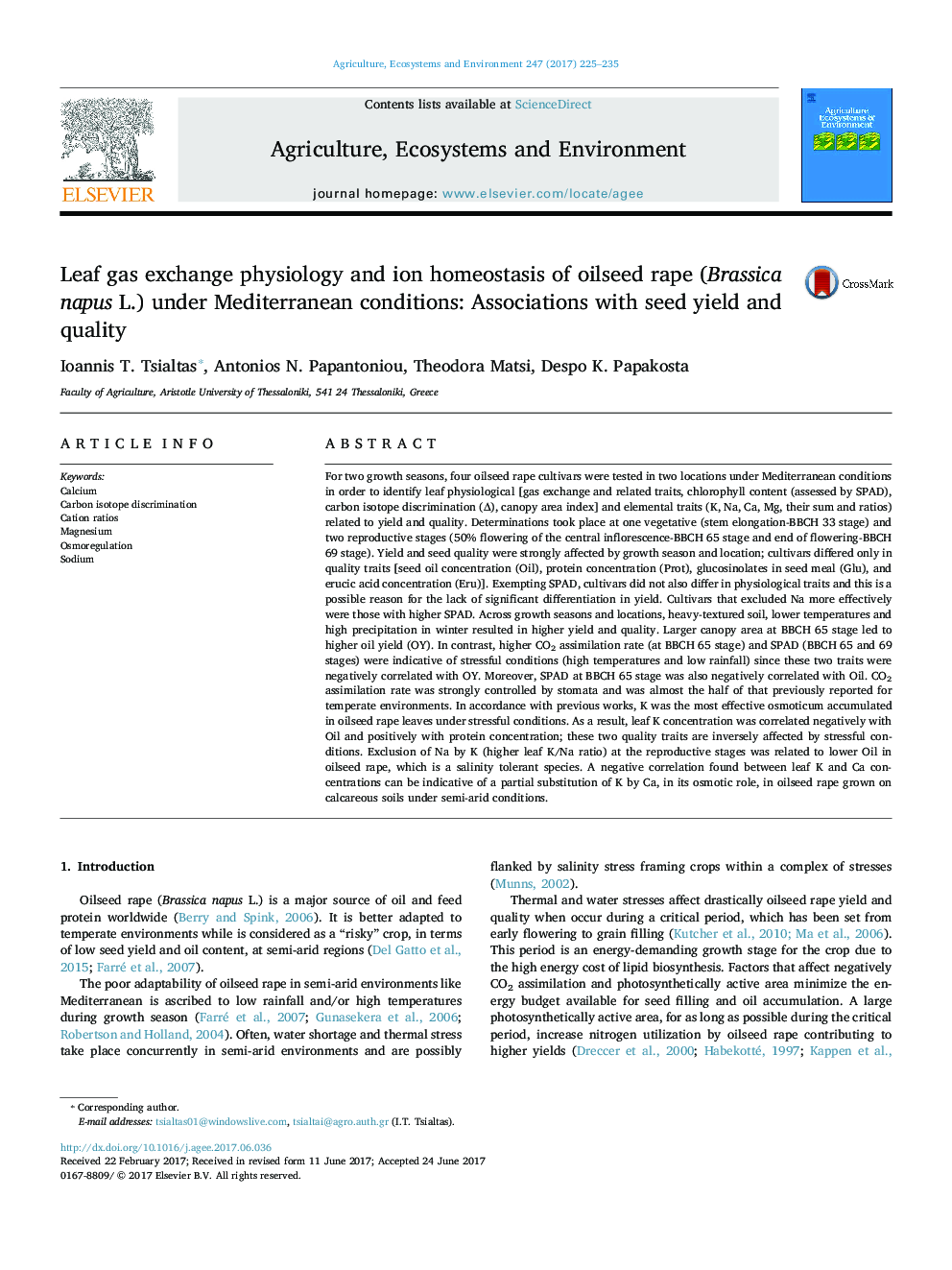| کد مقاله | کد نشریه | سال انتشار | مقاله انگلیسی | نسخه تمام متن |
|---|---|---|---|---|
| 5537996 | 1552005 | 2017 | 11 صفحه PDF | دانلود رایگان |
عنوان انگلیسی مقاله ISI
Leaf gas exchange physiology and ion homeostasis of oilseed rape (Brassica napus L.) under Mediterranean conditions: Associations with seed yield and quality
دانلود مقاله + سفارش ترجمه
دانلود مقاله ISI انگلیسی
رایگان برای ایرانیان
کلمات کلیدی
موضوعات مرتبط
علوم زیستی و بیوفناوری
علوم کشاورزی و بیولوژیک
علوم زراعت و اصلاح نباتات
پیش نمایش صفحه اول مقاله

چکیده انگلیسی
For two growth seasons, four oilseed rape cultivars were tested in two locations under Mediterranean conditions in order to identify leaf physiological [gas exchange and related traits, chlorophyll content (assessed by SPAD), carbon isotope discrimination (Î), canopy area index] and elemental traits (K, Na, Ca, Mg, their sum and ratios) related to yield and quality. Determinations took place at one vegetative (stem elongation-BBCH 33 stage) and two reproductive stages (50% flowering of the central inflorescence-BBCH 65 stage and end of flowering-BBCH 69 stage). Yield and seed quality were strongly affected by growth season and location; cultivars differed only in quality traits [seed oil concentration (Oil), protein concentration (Prot), glucosinolates in seed meal (Glu), and erucic acid concentration (Eru)]. Exempting SPAD, cultivars did not also differ in physiological traits and this is a possible reason for the lack of significant differentiation in yield. Cultivars that excluded Na more effectively were those with higher SPAD. Across growth seasons and locations, heavy-textured soil, lower temperatures and high precipitation in winter resulted in higher yield and quality. Larger canopy area at BBCH 65 stage led to higher oil yield (OY). In contrast, higher CO2 assimilation rate (at BBCH 65 stage) and SPAD (BBCH 65 and 69 stages) were indicative of stressful conditions (high temperatures and low rainfall) since these two traits were negatively correlated with OY. Moreover, SPAD at BBCH 65 stage was also negatively correlated with Oil. CO2 assimilation rate was strongly controlled by stomata and was almost the half of that previously reported for temperate environments. In accordance with previous works, K was the most effective osmoticum accumulated in oilseed rape leaves under stressful conditions. As a result, leaf K concentration was correlated negatively with Oil and positively with protein concentration; these two quality traits are inversely affected by stressful conditions. Exclusion of Na by K (higher leaf K/Na ratio) at the reproductive stages was related to lower Oil in oilseed rape, which is a salinity tolerant species. A negative correlation found between leaf K and Ca concentrations can be indicative of a partial substitution of K by Ca, in its osmotic role, in oilseed rape grown on calcareous soils under semi-arid conditions.
ناشر
Database: Elsevier - ScienceDirect (ساینس دایرکت)
Journal: Agriculture, Ecosystems & Environment - Volume 247, 1 September 2017, Pages 225-235
Journal: Agriculture, Ecosystems & Environment - Volume 247, 1 September 2017, Pages 225-235
نویسندگان
Ioannis T. Tsialtas, Antonios N. Papantoniou, Theodora Matsi, Despo K. Papakosta,